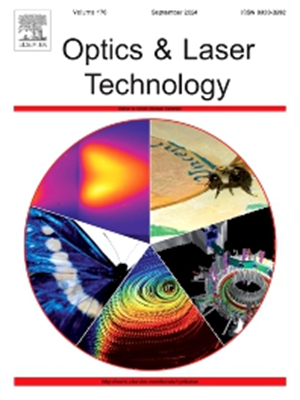车载激光雷达楔形棱镜表面缺陷成像检测与交通安全优化研究
IF 5
2区 物理与天体物理
Q1 OPTICS
引用次数: 0
摘要
楔形棱镜由于其独特的几何结构,在光学检测中提出了重大的技术挑战。获取高质量的数据集仍然是该领域的一个关键挑战。本文提出了一种基于入射角优化和反射面积预测的新方法,以提高成像质量。该方法确保了在激光雷达系统集成之前的制造过程中组件的最佳质量。利用米氏散射理论,我们确定了最佳入射角范围为20°-40°。与单波长成像相比,双波长成像在多个性能指标上都有显著改善。建立的楔形板厚度和光反射特性关系模型成功地预测了两个不同反射区的物理边界。实验验证了干涉反射和几何反射机制的存在。理论和实际图像反射区域的预测误差保持在20像素以内。定量分析表明,微米级光学缺陷严重影响车载激光雷达的性能。这种影响在强降雨条件下尤为明显,大大降低了系统的可靠性。该框架为改进激光雷达制造质量控制提供了基础,并使自动化检测系统的未来发展成为可能。本文章由计算机程序翻译,如有差异,请以英文原文为准。
Research on surface defect imaging detection and traffic safety optimization of vehicle-mounted lidar wedge prisms
Wedge prisms present significant technical challenges in optical detection due to their unique geometric structure. The acquisition of high-quality datasets remains a critical challenge in this field. This study proposes a novel method based on incident angle optimization and reflection area prediction to enhance imaging quality. The method ensures optimal component quality during manufacturing processes before LiDAR system integration. Using Mie scattering theory, we determined the optimal incident angle range of –. Dual wavelength imaging demonstrated significant improvements across multiple performance indicators compared to single wavelength approaches. The established model relating wedge thickness to light reflection characteristics successfully predicted physical boundaries of two distinct reflection areas. Experimental validation confirmed the existence of interference reflection and geometric reflection mechanisms. The prediction error between the theoretical and actual image reflection areas remained within pixels. Quantitative analysis reveals that micron-level optical defects significantly impact vehicle mounted LiDAR performance. This impact becomes particularly pronounced under heavy rainfall conditions, substantially reducing system reliability. This framework provides a foundation for improving LiDAR manufacturing quality control and enables future development of automated inspection systems.
求助全文
通过发布文献求助,成功后即可免费获取论文全文。
去求助
来源期刊
CiteScore
8.50
自引率
10.00%
发文量
1060
审稿时长
3.4 months
期刊介绍:
Optics & Laser Technology aims to provide a vehicle for the publication of a broad range of high quality research and review papers in those fields of scientific and engineering research appertaining to the development and application of the technology of optics and lasers. Papers describing original work in these areas are submitted to rigorous refereeing prior to acceptance for publication.
The scope of Optics & Laser Technology encompasses, but is not restricted to, the following areas:
•development in all types of lasers
•developments in optoelectronic devices and photonics
•developments in new photonics and optical concepts
•developments in conventional optics, optical instruments and components
•techniques of optical metrology, including interferometry and optical fibre sensors
•LIDAR and other non-contact optical measurement techniques, including optical methods in heat and fluid flow
•applications of lasers to materials processing, optical NDT display (including holography) and optical communication
•research and development in the field of laser safety including studies of hazards resulting from the applications of lasers (laser safety, hazards of laser fume)
•developments in optical computing and optical information processing
•developments in new optical materials
•developments in new optical characterization methods and techniques
•developments in quantum optics
•developments in light assisted micro and nanofabrication methods and techniques
•developments in nanophotonics and biophotonics
•developments in imaging processing and systems

 求助内容:
求助内容: 应助结果提醒方式:
应助结果提醒方式:


